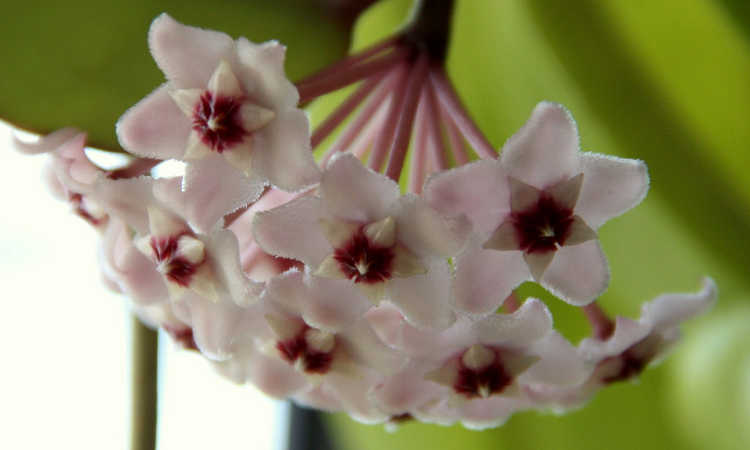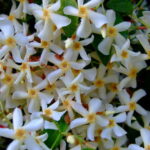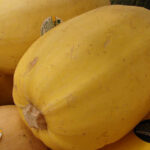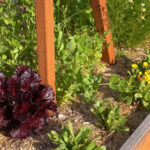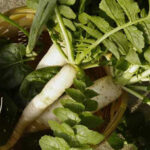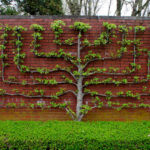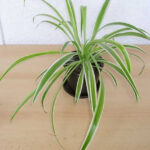- Quick Care Guide
- All About the Hoya Plant
- Types of Hoya Plants
- Hoya carnosa, ‘Wax Plant’, ‘Porcelainflower’, ‘Wax Flower Plant’, ‘Hindu Rope Plant’
- Hoya australis, ‘Common Waxflower’, ‘Waxvine’
- Hoya cinnamomifolia, ‘Wax Plant’
- Hoya kerrii, ‘Lucky-Heart’, ‘Sweetheart Plant’
- Hoya serpens, ‘Green Wax Plant’
- Hoya Plant Care
- Troubleshooting Hoyas
- Frequently Asked Questions
Epiphytic hoya plant, also known as the wax plant, is a popular houseplant. With clusters of star-shaped flowers adorning it, this waxy-looking species survives with only the bare minimum of care. But what does that care entail?
Today we’ll delve into the sweetly-scented world of the hoya to learn all about the best way to grow it. Every aspect of its care will be mentioned, from watering all the way through propagation.
By the time we’re done, you will be a hoya expert, and you’ll want to grow this bright, starry-flowered and aromatic plant at your home!
Helpful Products For Hoya Growers:
Quick Care Guide
| Common Name(s) | Hoya, wax plant, porcelainflower, wax flower plant, Hindu rope plant, common waxflower, waxvine, lucky-heart, sweetheart plant, green wax plant |
| Scientific Name | Hoya carnosa, Hoya australis, Hoya cinnamomifolia, Hoya kerrii, Hoya serpens, and many other Hoya species (200-300 more) |
| Family | Apocynaceae |
| Height | 2-4’ tall, up to 2’ feet wide |
| Light | Bright indirect light |
| Water | Only when soil is dry |
| Soil | Well-draining soil, orchid potting soil or blend with perlite, pine bark, and peat moss |
| Fertilizer | High nitrogen liquid for foliage, high phosphorous liquid to stimulate flower development |
| Pests and Diseases | Aphids, spider mites, mealybugs and other scale insects, caterpillars, snails and slugs, whiteflies, and thrips |
| Diseases | Sooty mold, root rot |
All About the Hoya Plant
The family of hoyas includes over 500 different species with multiple different cultivars. Some bear gorgeous and aromatic flowers, others are vines with a wide diversity of leaf shapes.
Most hoyas are native to Philippines, India, Thailand, Malaysia, Vietnam, Bangladesh, Indonesia, Polynesia, and New Guinea. Several hail from Austrailia. Some are epiphytic plants, while others live on the earth with roots dipping shallowly under the soil surface.
They have many different flower colors, but all are compound with star-shaped petals. They are pollinated by ants, moths, and flies, which assist in reproduction and development of small seeds. Outside their native range, local insects will pollinate them too.
Most of the time you’ll find hoyas in big box stores to be grown as houseplants. They’ve even been the center of major scams. Do not buy a Hoya kerrii leaf with its node stuck in soil. The plant will never root from this leaf cutting, and therefore will die. Even though you’ll see them sold this way, now you know not to buy them!
Types of Hoya Plants
While we can’t cover it all in one piece, let’s look at a few of the most popular varieties to grow at home.
Hoya carnosa, ‘Wax Plant’, ‘Porcelainflower’, ‘Wax Flower Plant’, ‘Hindu Rope Plant’
Sweet-smelling Hoya carnosa is one of the most popular of the hoya varieties. It won the Royal Horticultural Society’s Award of Garden Merit. Originating in eastern Asia and Australia, it has waxy foliage and star-shaped flowers common to all hoyas. It is a vining plant, and reputed to be a great cleanser of indoor air.
Hoya australis, ‘Common Waxflower’, ‘Waxvine’
With shiny, succulent leaves and a vining habit, the common waxflower is a butterfly attractant in its native Australia. This hoya loves bright light, growing along the edges of rainforests and on rocky outcroppings. It’s often grown as a houseplant, but waxvine can be grown indoors or outdoors in full sun conditions.
Hoya cinnamomifolia, ‘Wax Plant’
Originating on the island of Java, Hoya cinnamomifolia gets its name as the thick leaves resemble those of the Ceylon cinnamon or “true cinnamon” plant in shape and size. While this hoya is not often grown in gardens, it is notable because of its distinctive flowers, which have outer petals in green to yellow. The inner petals are a rich and bright pinkish-red to dark red.
Hoya kerrii, ‘Lucky-Heart’, ‘Sweetheart Plant’
Called “Lucky-Heart” or “Sweetheart” due to the shape of its leaves, Hoya kerrii comes from southeastern Asia. This is a very popular houseplant. When purchased at a garden center, this hoya is sold as a single heart-shaped leaf in a pot. It can’t root in this form, though, so don’t get scammed! Its flowers are pinkish to yellowish with a deeper pink center star.
Hoya serpens, ‘Green Wax Plant’
Found in the Himalayas, the green wax plant is a rapid-growing vine. Its flowers have a greenish tint and appear fuzzy. The only bright spot in these flowers comes from a tiny bit of yellow at the center flanked with hints of a deep pink. Otherwise, the rest of the flower is cream to pale green. This plant produces more round and waxy leaves than the pale green flowers, however.
Hoya Plant Care
Surprisingly, the wax plant is easy to care for. Once you’ve learned a few tricks, you’ll be able to grow this plant for years to come!
Light and Temperature
Bright, indirect light is perfect. While they tolerate full sun conditions in spring or fall, the summer sun can scorch hoya leaves and cause color bleaching. Ideally, ensure it has at least 6 hours of bright light per day. Using a grow light to supplement the sun is an option.
As a tropical plant, hoya prefers temperatures over 50 degrees Fahrenheit. Some varieties actually prefer it to be in the 60’s or 70’s. For indoor growers, this is perfect. Be sure of the lowest temperature for a specific hoya. Bring it indoors when the temps dip too low.
While there are cool-temperature hoyas which prefer it to stay below 80 degrees, the vast majority tolerate temps to 95 or higher. Give them protection from the heat during the hottest part of the day, and shade to keep the plants from wilting in direct sunlight.
Water and Humidity

As epiphytes, wax plants naturally live in low-water environments. They are easy to overwater, and suffer ill effects including root rot if kept in soggy conditions. Spring and summer are the times when a wax plant is thirstiest.
If the soil is dry in the top inch or two, water to moisten it. Do not flood the pot or allow water to pool. Allow the soil to completely dry out in those top inches before watering again. In the fall and winter months, hoya plants go somewhat due to cooler temperatures. During these times, water them much less. Many find that in the fall and winter, they only have to water about once per month.
Soil
Hoya plants are epiphytic and don’t require a traditional succulent potting mix. Often, a potting mix of pine bark, perlite and peat moss is perfect. One part pine bark to two parts peat moss, with a bit of dolomitic lime mixed in to reduce the acidity of the blend works too. Add perlite to lighten it and increase drainage capability. Commercial potting mix may need extra perlite to lighten it up significantly. An orchid mix is a good choice, as it is light and well-draining.
Fertilizer
As the hoya is mostly a foliage plant, it requires a lot of nitrogen. Give new plants a high nitrogen fertilizer once or twice a month. Use a 2-1-2 or 3-1-2 liquid. Once your plant is a good size, switch to a high phosphorous fertilizer to encourage blooming. Dilute a liquid 5-10-5. Each kind of hoya blooms at different times during the spring or summer. Switch to a high phosphorous fertilizer about a month prior to your plant’s blooming period to produce stunning hoya flowers. Do not fertilize in fall and winter.
Propagation
The easiest ways to propagate hoya are from stem cuttings or layering. Take stem cuttings from the softer wood or new growth of the plant. Make them 4-6″ long with a few leaves. Root these in water or in a lightly-dampened growth medium. Cuttings root quite well and will grow more quickly and readily than other leaf cuttings.
Mound layering is a technique where you use pins to anchor a softwood tendril from one plant to the soil to encourage it to put down roots. This can take time, but it’s effective. Extend a tendril to a second pot and pin it there. The roots will form from the stem. Once it seems established, snip the tendril free from its mother plant. It will develop on its own.
Repotting Hoya Plants
Hoya likes to be rootbound to produce flowers. However, they eventually outgrow their containers or hanging baskets. If you see roots around drainage holes, it’s time to repot! Test plants in flexible plastic pots by gently pressing against the pot’s sides. If it’s firm and has no give, it’s time to repot.
Repot your hoya in the spring or early summer, when it’s in its active growing stage. Select a pot no larger than 1-2 inches wider and taller than your current one. Do not repot it any lower in the pot than it was in its earlier pot. While hoya plants can form roots along stems, they also require airflow to avoid damage like rot or decay.
Pruning Your Hoya
While hoyas are hardy, they require maintenance for health and happiness. Remove wilted, damaged, or dead branches/leaves. Prune away diseased leaves too. Any other pruning is purely cosmetic, but should be done with caution. For hoyas, new flower buds grow on older flower stems called spurs. Those spurs will flower year after year. Avoid removing those to ensure your plant continues flowering.
Don’t remove too much of the trailing length of your hoya. Not only are those trailing arms beautiful, they’re also necessary. If the plant cannot grow in size, it won’t fill its pot and start producing those star-shaped flowers we all want.
Troubleshooting Hoyas
Hoya plant care involves very few problems. It’s good for those of all gardening kill levels. However, there are a few issues you may encounter. This section will help you figure out what went wrong.
Growing Problems
Most growing problems spur from watering issues. It’s easy to overwater a hoya. That can induce rot and kill your plant. However, underwatering causes wilting and yellowing of leaves. Due to the epiphytic nature of hoya, err on the side of underwatering. Water carefully and in limited amounts.
Pests
Most of the pests which will attack hoya are sap-suckers. Aphids, mealy bugs and other scale insects, and spider mites are the most common culprits. Thankfully, all of these pests can be controlled with the use of neem oil. Simply spray neem oil on all surfaces of the plant, and it should reduce or remove the population of these common pests entirely.
Whiteflies and thrips can become problematic if they’re in high population numbers in your yard already, but the hoya isn’t their first choice. Use insecticidal to combat whiteflies and thrips, although thrips also respond to the use of neem oil. Use BT spray to wipe out caterpillars on your plants.
The only other pests you’ll need to watch for are snails and slugs. Use something like bait or a beer trap to keep these at bay.
However, if you’re growing hoya to attract local pollinators, use caution when applying neem oil and insecticidal soap. If you must use either, dilute them, and only spray in the early morning before pollinators are out doing their work. Otherwise you could harm or kill them. There is a lot of debate as to whether or not following this formula can still harm pollinators.
Diseases
The most common disease that occurs during hoya plant care is sooty mold. This black mold forms on thick leaves that are sticky with plant saps or pest honeydew. Thankfully, sooty mold is easy to treat. Wipe off the mold with a damp cloth. If you want, spray a diluted seaweed fertilizer over the area where the mold formed.
Botyris blight can form on the leaves of hoyas. This starts as greyish fungal patches towards the center of the plant. As it develops, it causes mushy leaves or leaf collapse. Treat this with a copper fungicide.
Finally, there is the dreaded root rot. Caused by moisture in the soil which aids fungal development, prevent this by not overwatering. If your plant wilts or forms black or brown stem or leaf lesions, rot may be the cause. Spray a copper fungicide both on the soil and the plant itself to reduce the effects of root rot. If the roots themselves are black and mushy, your plant is beyond redemption, and should be disposed of.
Frequently Asked Questions
Q: Why is my hoya plant not flowering?
A: If it’s too young, it won’t flower. Hoya likes to be a bit rootbound to produce flowers. Pruning heavily may remove the flower spurs from which the flowers grow. And it might need more phosphorous to stimulate flower growth. Sometimes, if you wait a year your hoya will flower.
Q: I got a hoya kerrii and it’s not growing.
A: Hoya kerrii is often propagated through leaf cutting. Unfortunately, leaf cutting is one of the slowest and nearly impossible ways to generate more hoyas, and it can take a couple years before it really shows signs of much growth.
Q: Do hoyas like sun or shade?
A: Most prefer bright, indirect light.
Q: Is hoya plant good for indoor?
A: It’s an excellent indoor plant!
Q: What is so special about hoyas?
A: Not only do they live a long time, they are striking in both foliage and flower. And they love indoor conditions, and outdoor ones in select areas.
Q: Should hoyas climb or hang?
A: It depends on the variety you have. If you have vining hoyas, plant them in hanging baskets. If not, try a regular container.
Q: How often should I water Hoya?
A: Wait for the top two inches of soil to dry and then add some water.
Q: How long do Hoya plants live?
A: They can live for 30-plus years!

